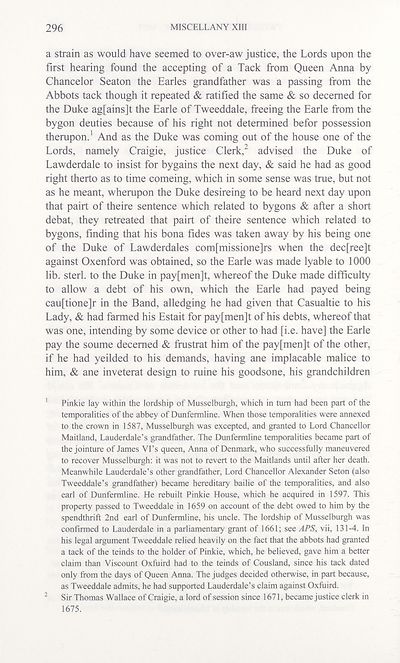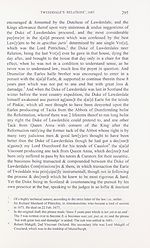Series 5 > Miscellany [of the Scottish History Society] XIII
(311) Page 296
Download files
Complete book:
Individual page:
Thumbnail gallery: Grid view | List view

296
MISCELLANY XIII
a strain as would have seemed to over-aw justice, the Lords upon the
first hearing found the accepting of a Tack from Queen Anna by
Chancelor Seaton the Earles grandfather was a passing from the
Abbots tack though it repeated & ratified the same & so decerned for
the Duke ag[ains]t the Earle of Tweeddale, freeing the Earle from the
bygon deuties because of his right not determined befor possession
therupon.1 And as the Duke was coming out of the house one of the
Lords, namely Craigie, justice Clerk,2 advised the Duke of
Lawderdale to insist for bygains the next day, & said he had as good
right therto as to time comeing, which in some sense was true, but not
as he meant, wherupon the Duke desireing to be heard next day upon
that pairt of theire sentence which related to bygons & after a short
debat, they retreated that pairt of theire sentence which related to
bygons, finding that his bona fides was taken away by his being one
of the Duke of Lawderdales com[missione]rs when the dec[ree]t
against Oxenford was obtained, so the Earle was made lyable to 1000
lib. sterl. to the Duke in pay[men]t, whereof the Duke made difficulty
to allow a debt of his own, which the Earle had payed being
cau[tione]r in the Band, alledging he had given that Casualtie to his
Lady, & had farmed his Estait for pay[men]t of his debts, whereof that
was one, intending by some device or other to had [i.e. have] the Earle
pay the soume decerned & frustrat him of the pay[men]t of the other,
if he had yeilded to his demands, having ane implacable malice to
him, & ane inveterat design to mine his goodsone, his grandchildren
1 Pinkie lay within the lordship of Musselburgh, which in turn had been part of the
temporalities of the abbey of Dunfermline. When those temporalities were annexed
to the crown in 1587, Musselburgh was excepted, and granted to Lord Chancellor
Maitland, Lauderdale’s grandfather. The Dunfermline temporalities became part of
the jointure of James Vi’s queen, Anna of Denmark, who successfully maneuvered
to recover Musselburgh: it was not to revert to the Maitlands until after her death.
Meanwhile Lauderdale’s other grandfather, Lord Chancellor Alexander Seton (also
Tweeddale’s grandfather) became hereditary bailie of the temporalities, and also
earl of Dunfermline. He rebuilt Pinkie House, which he acquired in 1597. This
property passed to Tweeddale in 1659 on account of the debt owed to him by the
spendthrift 2nd earl of Dunfermline, his uncle. The lordship of Musselburgh was
confirmed to Lauderdale in a parliamentary grant of 1661; see APS, vii, 131-4. In
his legal argument Tweeddale relied heavily on the fact that the abbots had granted
a tack of the teinds to the holder of Pinkie, which, he believed, gave him a better
claim than Viscount Oxfuird had to the teinds of Cousland, since his tack dated
only from the days of Queen Anna. The judges decided otherwise, in part because,
as Tweeddale admits, he had supported Lauderdale’s claim against Oxfuird.
2 Sir Thomas Wallace of Craigie, a lord of session since 1671, became justice clerk in
1675.
MISCELLANY XIII
a strain as would have seemed to over-aw justice, the Lords upon the
first hearing found the accepting of a Tack from Queen Anna by
Chancelor Seaton the Earles grandfather was a passing from the
Abbots tack though it repeated & ratified the same & so decerned for
the Duke ag[ains]t the Earle of Tweeddale, freeing the Earle from the
bygon deuties because of his right not determined befor possession
therupon.1 And as the Duke was coming out of the house one of the
Lords, namely Craigie, justice Clerk,2 advised the Duke of
Lawderdale to insist for bygains the next day, & said he had as good
right therto as to time comeing, which in some sense was true, but not
as he meant, wherupon the Duke desireing to be heard next day upon
that pairt of theire sentence which related to bygons & after a short
debat, they retreated that pairt of theire sentence which related to
bygons, finding that his bona fides was taken away by his being one
of the Duke of Lawderdales com[missione]rs when the dec[ree]t
against Oxenford was obtained, so the Earle was made lyable to 1000
lib. sterl. to the Duke in pay[men]t, whereof the Duke made difficulty
to allow a debt of his own, which the Earle had payed being
cau[tione]r in the Band, alledging he had given that Casualtie to his
Lady, & had farmed his Estait for pay[men]t of his debts, whereof that
was one, intending by some device or other to had [i.e. have] the Earle
pay the soume decerned & frustrat him of the pay[men]t of the other,
if he had yeilded to his demands, having ane implacable malice to
him, & ane inveterat design to mine his goodsone, his grandchildren
1 Pinkie lay within the lordship of Musselburgh, which in turn had been part of the
temporalities of the abbey of Dunfermline. When those temporalities were annexed
to the crown in 1587, Musselburgh was excepted, and granted to Lord Chancellor
Maitland, Lauderdale’s grandfather. The Dunfermline temporalities became part of
the jointure of James Vi’s queen, Anna of Denmark, who successfully maneuvered
to recover Musselburgh: it was not to revert to the Maitlands until after her death.
Meanwhile Lauderdale’s other grandfather, Lord Chancellor Alexander Seton (also
Tweeddale’s grandfather) became hereditary bailie of the temporalities, and also
earl of Dunfermline. He rebuilt Pinkie House, which he acquired in 1597. This
property passed to Tweeddale in 1659 on account of the debt owed to him by the
spendthrift 2nd earl of Dunfermline, his uncle. The lordship of Musselburgh was
confirmed to Lauderdale in a parliamentary grant of 1661; see APS, vii, 131-4. In
his legal argument Tweeddale relied heavily on the fact that the abbots had granted
a tack of the teinds to the holder of Pinkie, which, he believed, gave him a better
claim than Viscount Oxfuird had to the teinds of Cousland, since his tack dated
only from the days of Queen Anna. The judges decided otherwise, in part because,
as Tweeddale admits, he had supported Lauderdale’s claim against Oxfuird.
2 Sir Thomas Wallace of Craigie, a lord of session since 1671, became justice clerk in
1675.
Set display mode to:
![]() Universal Viewer |
Universal Viewer | ![]() Mirador |
Large image | Transcription
Mirador |
Large image | Transcription
Images and transcriptions on this page, including medium image downloads, may be used under the Creative Commons Attribution 4.0 International Licence unless otherwise stated. ![]()
| Scottish History Society volumes > Series 5 > Miscellany [of the Scottish History Society] XIII > (311) Page 296 |
|---|
| Permanent URL | https://digital.nls.uk/127317261 |
|---|
| Description | Over 180 volumes, published by the Scottish History Society, containing original sources on Scotland's history and people. With a wide range of subjects, the books collectively cover all periods from the 12th to 20th centuries, and reflect changing trends in Scottish history. Sources are accompanied by scholarly interpretation, references and bibliographies. Volumes are usually published annually, and more digitised volumes will be added as they become available. |
|---|


